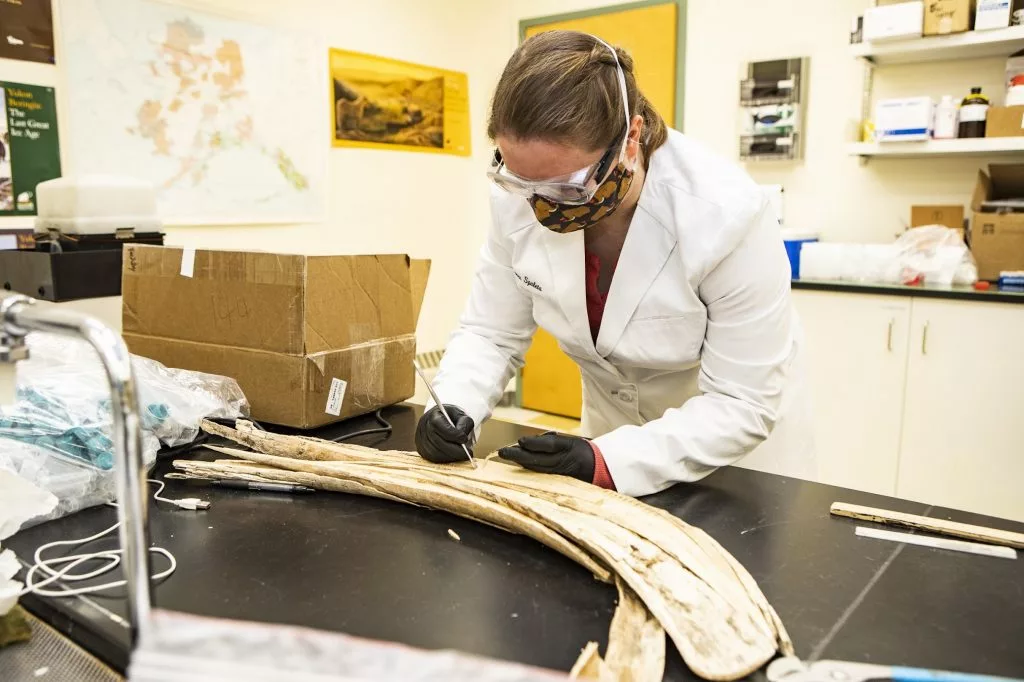Genetic and isotopic analyses have pieced together a remarkable narrative of a 20-year-old female woolly mammoth, detailing her health, social status and travels – even though her story is more than 14,000 years old. It offers new insight into mammoth behavior and clues as to how humans interacted with the dwindling great beasts.
Researchers from McMaster University, University of Alaska Fairbanks (UAF) and the University of Ottawa undertook this ambitious project to chronicle the life of the mammoth named Élmayuujey’eh by the Healy Lake Village Council, who was discovered at Swan Point in Alaska, alongside the remains of two males – one juvenile and one baby.
Swan Point, Alaska’s earliest archeological site, has been a treasure trove for scientists, with mammoth remains having been unearthed at three other spots all within 10 km (6.2 miles) of where Élmayuujey’eh was found. Isotopic analysis of a complete tusk and genetic testing of other mammoths confirmed what the team suspected: Swan Point was an area of significance for at least two related but distinct matriarchal herds.
“This is a fascinating story that shows the complexity of life and behavior of mammoths, for which we have very little insight,” says evolutionary geneticist Hendrik Poinar, director of the Ancient DNA Centre at McMaster University.
Poinar headed a team of researchers tasked with sequencing the mitochondrial genomes of eight woolly mammoths found at Swan Point and surrounds. It was crucial genetic detective work that helped establish family ties.

Meanwhile, UAF researchers analyzed Élmayuujey’eh’s tusk, finding approximately 20 years of growth layers on the interior, establishing her life span. They then measured its isotopic profile for those layers, tracking strontium, oxygen, nitrogen, sulfur and inorganic carbon elements. It gave them a full picture of her geographic and seasonal movements throughout her 20-year life.
What they found was that this mammoth most likely spent her early years within a relatively small area – much like modern juvenile elephants – in southeastern Beringia near the Cordilleran ice sheet. During the middle of her life, she went further afield, wandering around 1,000 km (620 miles) in three years, most likely in a northwest direction through the White Mountains and near to the Brooks Range. In her twilight years, she slowed down, and was also carrying young with her. She moved around and frequently returned to interior Alaska for around three years until her death at Swan Point. The researchers were also able to determine that the mammoth preferred the highlands, with delta-N-15 levels hinting at a diet of plants in more arid habitats. Modern plants at higher elevation have higher delta-N-15 levels, too.
While there was no weaponry found near her remains, her premature death – the animals are thought to have lived up to 60 years of age – plus crossover timeline with the earliest human inhabitants, suggest she was likely a victim of a hunt. She was found at the site of a seasonal hunting camp, which may have been established based on mammoth movements and played a role in their localized extinction in Alaska.
“She was a young adult in the prime of life,” said Matthew Wooller, UAF professor and director of the Alaska Stable Isotope Facility, who worked alongside co-author Karen Spaleta to tease out the mammoth's isotopic story. “Her isotopes showed she was not malnourished and that she died in the same season as the seasonal hunting camp at Swan Point where her tusk was found.”
DNA sourced from Élmayuujey’eh’s tusk, along with that of the other tusks, teeth and ribs found at the various sites, found that this mammoth was closely but not directly related to the juvenile and baby male found at the site, and distantly related to the animals found at the nearby Holzman site. The researchers believe Élmayuujey’eh may have been the matriarch of her herd, as generations separated her from the two young mammoths she was with.
“This is more than looking at stone tools or remains and trying to speculate,” said Tyler Murchie from McMaster University, who conducted the DNA study with Sina Baleka. “This analysis of lifetime movements can really help with our understanding of how people and mammoths lived in these areas. We can continue to significantly expand our genetic understanding of the past, and to address more nuanced questions of how mammoths moved, how they were related to one another and how that all connects to ancient people.”
The findings have been published in the journal Science Advances.
The researchers detail their fascinating study in the video below.
Source: McMaster University





